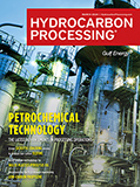Treating
Optimize the selection of sulfur unit blocks and process technology combinations
Since the 1940s, the present form of the Claus sulfur recovery unit (SRU) has been successfully applied in the refining and gas processing industries.
Protect your assets and our environment
Process cooling usually comprises the largest part of the water footprint of a refinery or petrochemical plant.
Industry Perspective: IRPC Americas ONLINE: A sincere thanks
Each year, <i>Hydrocarbon Processing</i> hosts events to bring together professionals in the oil and gas industry to share ideas and knowledge on the latest advancements in processing technologies and operations.
Hydrocarbon Processing 2020 Awards WINNERS
<i>Hydrocarbon Processing</i>, the downstream processing sector’s leading technical publication, has announced the winners for its third annual awards.
Hydrocarbon Processing Awards 2020—FINALISTS
This special section details all finalists within each category for the fourth annual <ital>HP</ital> Awards. The winners will be announced on Oct. 1.
Advanced cooling tower water treatment—Part 1
Refineries, petrochemical plants and similar facilities rely on a significant number of heat exchangers for process control and product formulation throughout the plant.
Improve the safety and efficiency of natural gas sweetening units
After natural gas is extracted from onshore and offshore sites, it must be transported and processed.
Intensification of sulfur processing units by oxygen enrichment and process flowsheet optimization
The consistent global trend toward improvements in air quality and tighter regulations on emissions, as well as the International Maritime Organization’s shipping regulations, continue to mitigate sulfur levels—not only in conventional transport fuels (petrol and diesel), but also in jet fuels, fuel oils and other heavier distillates.
Use submerged combustion systems to efficiently destroy hazardous plant waste
In the production of clean fuels, plastics and other hydrocarbon-based products, refineries and petrochemical facilities generate unwanted (waste) byproducts. Having no market value, the undesired byproducts must be recycled, minimized or eliminated. Depending on the feedstocks, end products and reactant materials, the unwanted materials can be gases, liquids or multiphase materials.
Hydrocarbon Processing Awards Winners
<i>Hydrocarbon Processing,</i> the downstream processing sector’s leading technical publication, has announced the winners for its third annual awards. The <i>HP</i> Awards celebrate innovative technologies and people that have been instrumental in improving facility operations over the past year.

- China's March jet fuel exports jump 77.4% from a year earlier 4/18
- Nigeria strikes deal with Shell to supply $3.8-B methanol project 4/18
- Singapore fuel oil stockpiles rebound to 8-week high on higher imports 4/18
- Clariant launches new CATOFIN 312 propane dehydrogenation catalyst 4/18
- Solvay inaugurates new blowing agent production unit in Rosignano, Italy 4/18
- Meridian Energy Group’s Davis Refinery Project in North Dakota (U.S.) will be the world’s first net-zero carbon refinery 4/17




